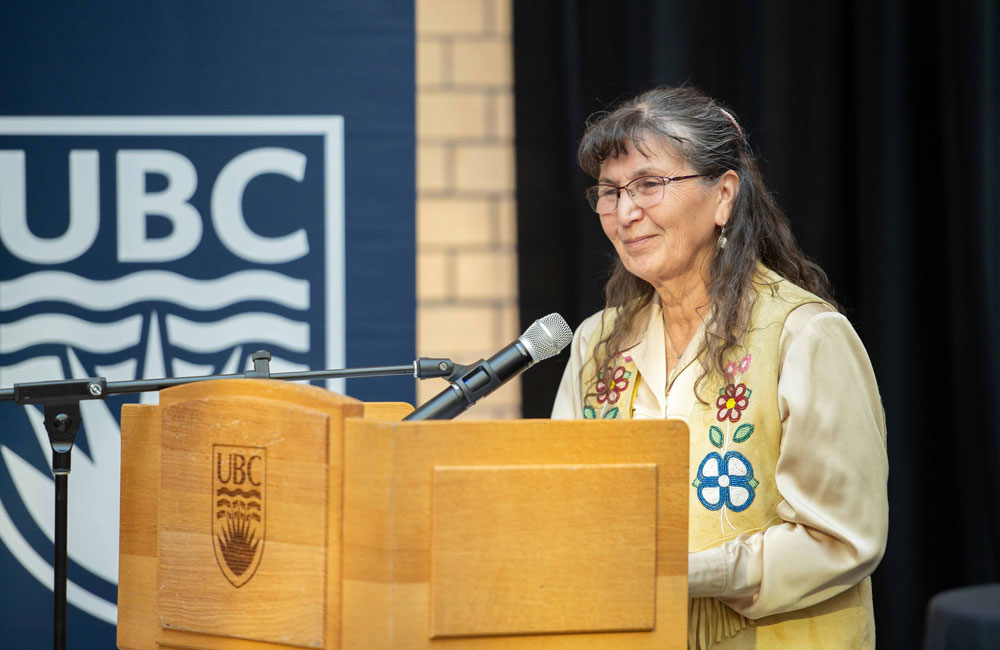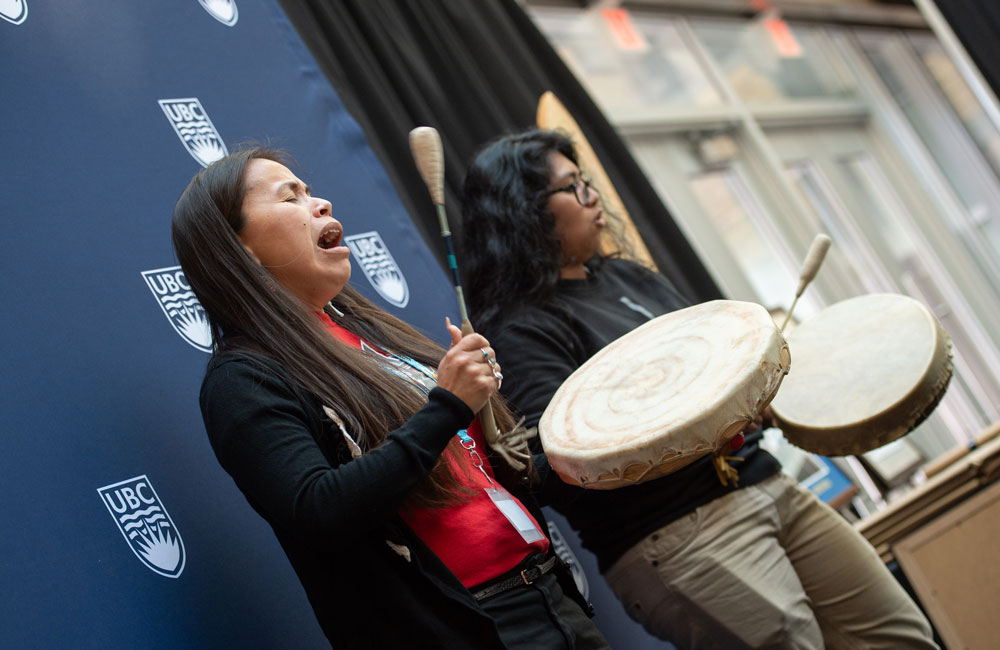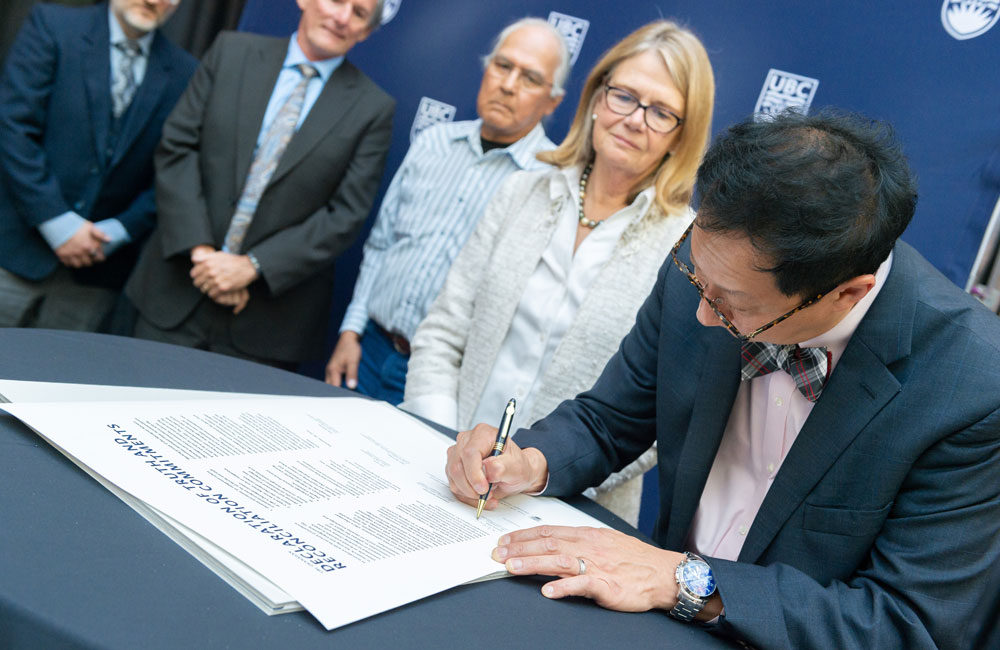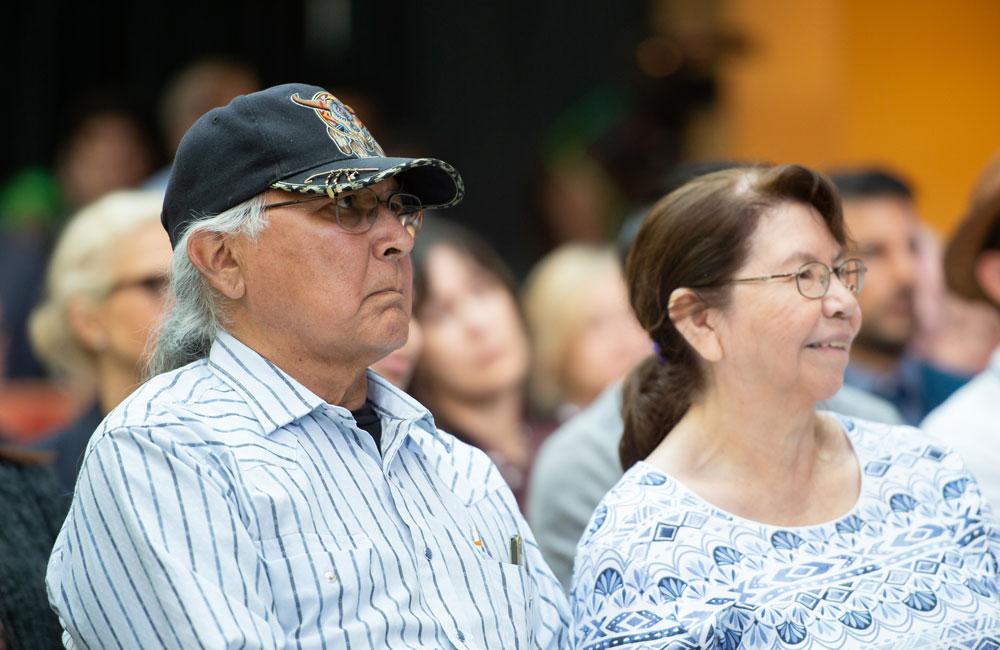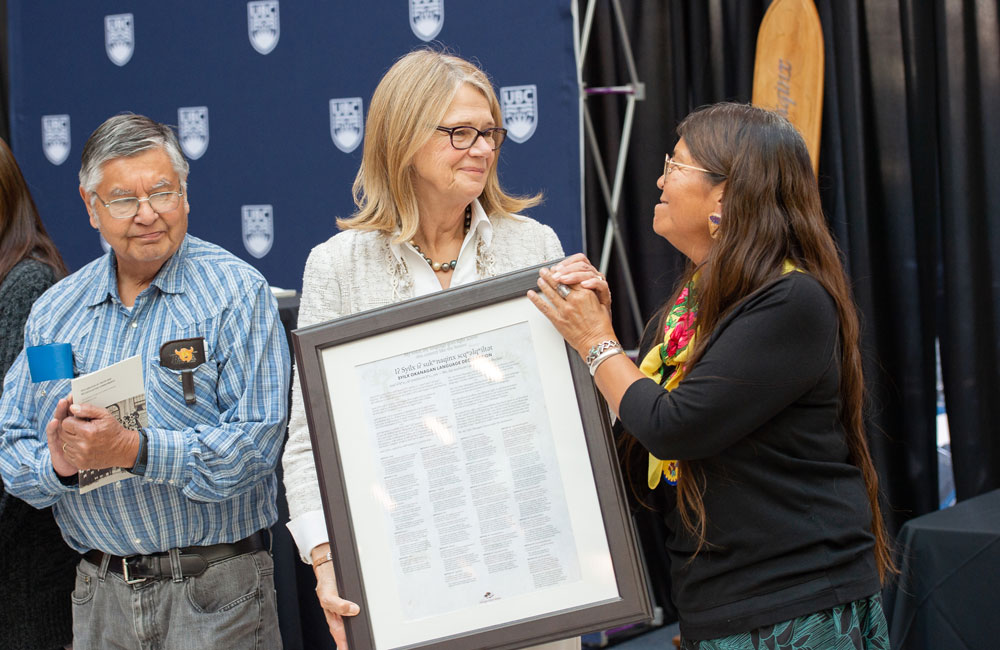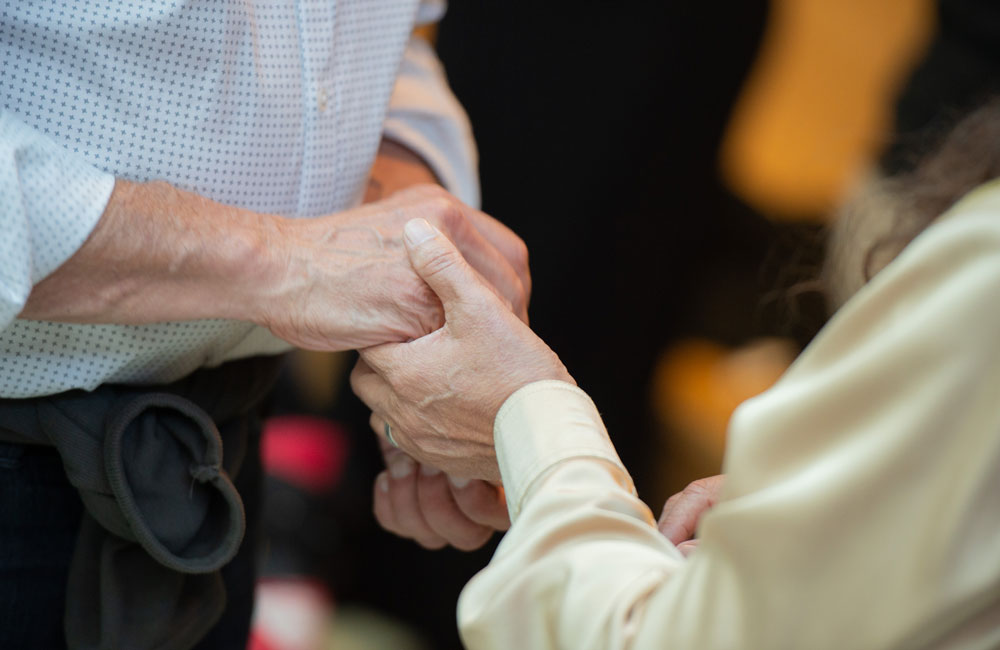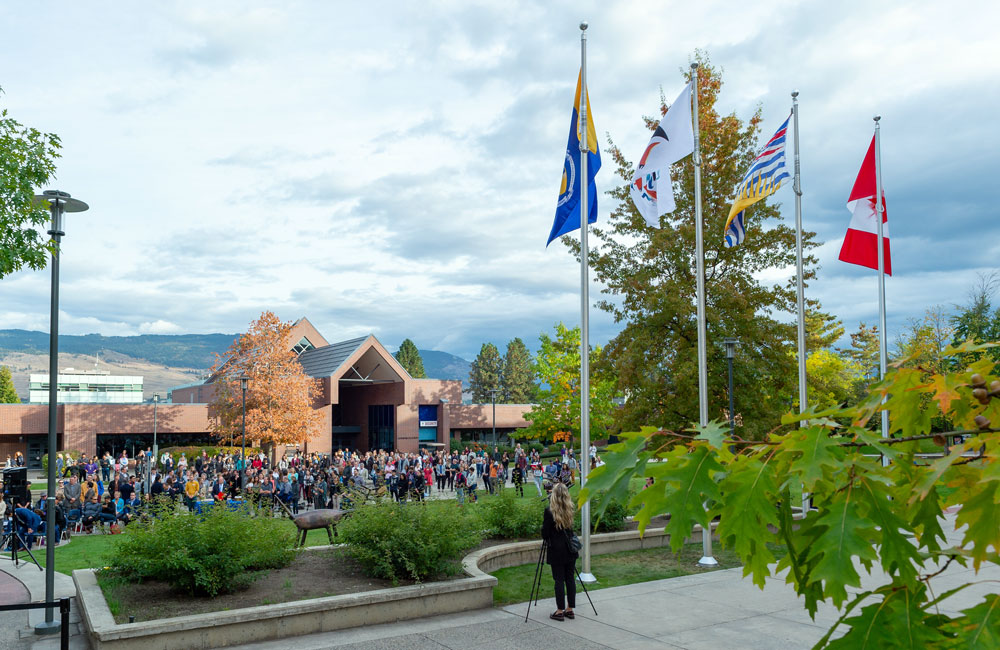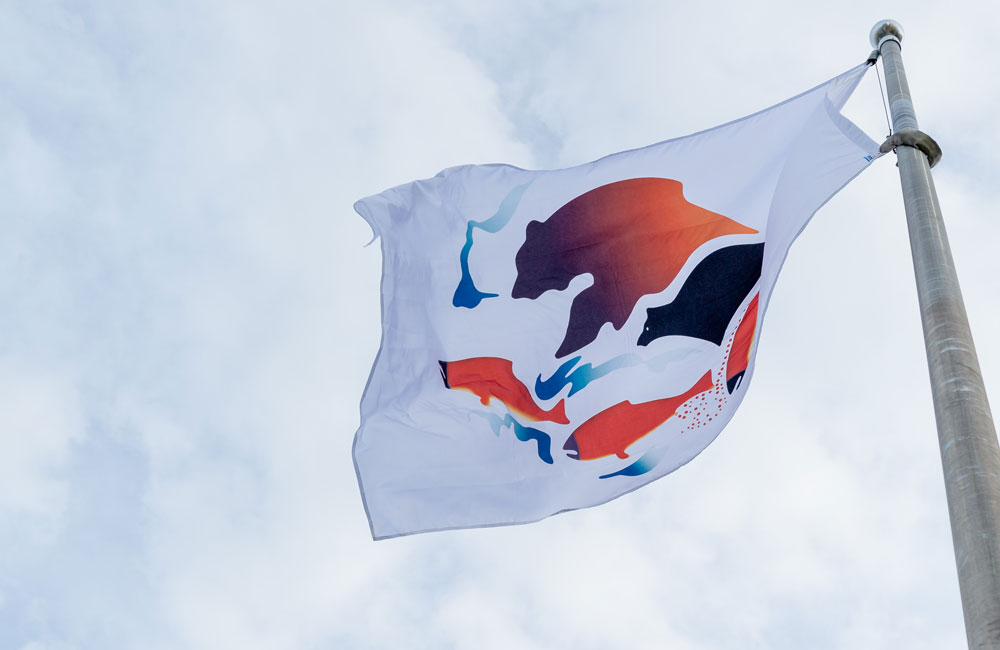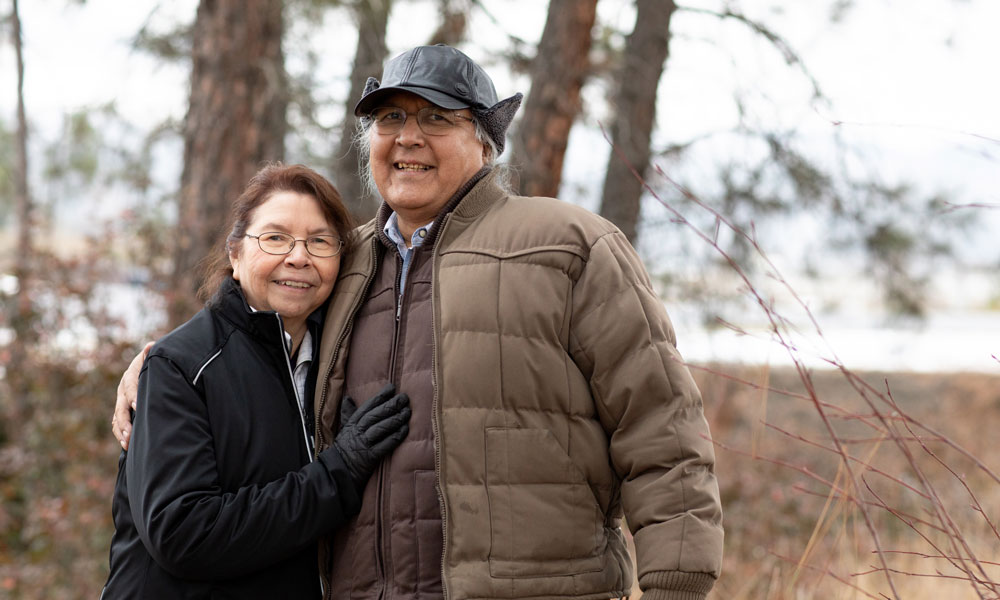
WE STAND IN A CIRCLE. Nine UBC Okanagan faculty and staff. Our group represents diverse fields of research, different countries and unique cultural backgrounds. Perhaps like many of the participants, I am a little uncertain, a bit wary of what exactly a cultural safety training workshop is about. Syilx Elders and traditional Okanagan knowledge keepers Christina (Chris) Marchand and Eric Mitchell, who are conducting the cultural safety training, stand with us.
“Circles are important,” says Marchand, slowly meeting the eyes of each participant. Her energy is palpable, as if literally holding up the circle from its centre.
“We are all a part of this circle,” she says. “Together we create this safe place.”
Marchand gestures to herself and then Mitchell, her partner in this work and life. “It takes a lot for us to be here in front of you to speak our truths,” she says. She then explains that today, and each day in this four-day course, we will open by standing together in a circle. “It is our way to honour each other; to begin to build a foundation of trust and truth.”
Marchand holds her hands with her palms facing up. Some participants look around a little uneasily, others cast stares at their shoes. I clasp my notepad, intent on recording information to take away.
Mitchell raises his hand and motions to those reflexively going for pens. “Put your paper and pens away. You won’t need them,” says Mitchell. “Today, and for the next few, you won’t learn with just your minds. You will learn with your hearts too,” says Marchand.
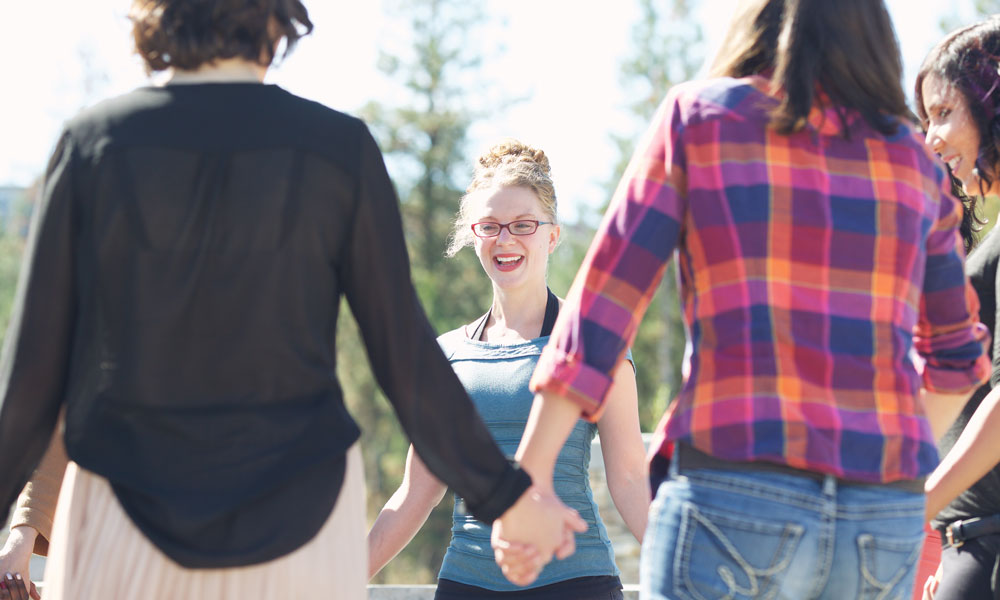
Day 1: Preparing for the truth
And so begins our journey of cultural safety training together. Each with our own ways of seeing the world, each with our own separate life experiences and our own conditioning and biases—but here willing to open, listen, shift perspectives and understand.
As Marchand and Mitchell tactfully yet whole-heartedly layout, we find ourselves at this place in history together—a time when we need to hear the truth, no matter how difficult it will be.
On September 24, 2019, UBC Okanagan made an official declaration in response to the Truth and Reconciliation Commission of Canada’s 94 Calls to Action. At the historic signing of the declaration, Syilx Knowledge Keeper and Canada Research Chair in Okanagan Indigenous Knowledge and Philosophy Jeannette Armstrong greeted the audience in the Syilx Okanagan language, nsyilxcn. Armstrong, an associate professor at UBCO, then announced UBC Okanagan’s five commitments and explained the commitments have been made to: “Advance the process of Canadian reconciliation and redress the legacy of Indian residential schools that operated in Canada from 1838 to 1996 with the intent of forcibly assimilating Indigenous children into the dominant culture and as part of a broader policy of cultural genocide.”
Number one on the list of five commitments—to develop and deliver an Indigenous culture orientation program for all UBCO faculty and staff—is underway.
As adjunct professors with the Faculty of Creative and Critical Studies, Marchand and Mitchell are our guides along this long road named reconciliation unwinding before us.
The cultural safety workshop we are taking part in today only exists due to the coordination and continual efforts of many. Since 2008, a cultural safety training course has been part of the UBC Okanagan curriculum for third-year nursing students.
As our small group of mostly faculty take seats, which are also placed in a circle at the centre of the classroom, Mitchell explains why the word truth must come before reconciliation. “You cannot have reconciliation before you know the truth,” he says. “And that’s what we are going to do—we are going to tell you the truth.”
Marchand and Mitchell have shared the truth for over two decades, beginning in high schools in Vernon in the 1990s. Long before there was a Truth and Reconciliation Commission, they told this story. Still, they are patient. They start slowly. They know the information they are sharing isn’t easy for people to hear. As Mitchell explains: Either it’s a story we think we already know or it’s so different from what we have believed, that it’s hard to hear.
“One of the things people who go through this course say, is: ‘I didn’t know that I didn’t know.’ They think they know but they don’t until they go through a process of learning,” says Mitchell.
Mitchell shifts forward a little and narrows his gaze. “The learning has to go from here,” he says, placing a hand across his forehead, “to here,” he says, slowly moving his large hand over his heart. “That’s the only way. And it’s not easy. It’s a process each of us must take for ourselves.”
Mitchell first began teaching cultural safety in the early 1990s when the principal of a Vernon high school sought to understand why his Indigenous students were struggling.
“This principal, he’d ask me a question and I’d answer him kind of lightly because usually, people didn’t really want to know,” says Mitchell. “But he kept after me. And after me. And finally,” says Mitchell, leaning forward, “I looked him in the eye and said: ‘I don’t know if you really know enough about us [Syilx people] to ask me that question and fully understand what you are asking.’”
“You cannot have reconciliation before you know the truth.”
But the principal persisted and Mitchell relented, explaining the long history of his people from his perspective. After four hours of listening, the principal, visibly moved, was dumbstruck. They sat together in a heavy silence. And then, the principal insisted something needed to be done. Other people needed to experience this, to hear and understand this story.
Inspired by that conversation with the principal, Mitchell fashioned a course for teachers that evolved into what they teach today.
“Before the term cultural safety was coined we were just trying to give Indigenous students a better chance at succeeding in a colonized system,” explains Mitchell.
You can tell this isn’t their first workshop. Marchand and Mitchell go back and forth seamlessly in what feels like a carefully choreographed but deeply sincere presentation.
“Before we share our story it’s important that we all make it a safe enough place for everyone,” says Marchand. “It’s not an easy story to tell and it’s not an easy story to hear.”
Marchand explains it is crucial that they carefully prepare participants on the first day. Often, she says, participants think they already know about the unjust treatment inflicted on Indigenous populations of Canada.
I thought I knew all about the injustices the Canadian government inflicted on Indigenous populations.
But only a few minutes into the first part of the workshop Mitchell calls “the hidden history of Canada” something changes. I begin to realize just how much, as Mitchell says, “I didn’t know I didn’t know.”
Dean of the Faculty of Critical and Creative Studies Bryce Traister says: “Working with Marchand and Mitchell has been transformational for me as an academic leader, as a settler Canadian and as a person. I view their work with our creative and critical studies community to be one of the most important initiatives in the history of our faculty, and our campus.”
Allison Hargreaves, associate professor in the Department of English and Cultural Studies, teaches decolonization studies, reconciliation and Indigenous literature. An educated and informed ally, Hargreaves acts as liaison and coordinator between Marchand, Mitchell and the faculty. She explains that this workshop is a safe place to work through how faculty talk about Canadian and colonial history in the classroom.
“That’s what this workshop is created for,” says Hargreaves. “So faculty aren’t working out their preconceptions with students whose lived knowledge of colonial history means that they may not feel safe in their own classrooms.”
There are more than 700 students who identify as Indigenous at UBCO.
“And if they have a teacher like Allison,” says Marchand, “Indigenous students feel safer. Once Indigenous people leave our communities we can become disconnected. If we can regain connection here at UBCO, then we can carry on what needs to be done.”
Day 2: Not the Canada we thought we knew
Mitchell extends his arm into the centre of our circle, and with an intentional and calm voice begins: “In Canada, there’s a dark hole that hardly anybody knows about. We are going to take a peek into this dark hole you don’t hear much about,” he says moving to the edge of his chair and staring into the imagined black hole at the centre of our circle. “We are going to share a few bits of that with you now.”
The energy in the room changes. Legs fold, arms cross. Some shift uneasily.
“Be kind to yourselves. Be patient with yourself. We are not here to blame or offend but, our truth, you can’t really tell it any other way,” says Mitchell.
Marchand asks the group to close their eyes. The imaginary dark hole is about to become all too real.
“And keep them closed. No peeking,” she adds, as Mitchell moves a little closer to the centre of the circle and begins to read a letter written in 1910 to Sir Wilfred Laurier, Prime Minister at the time.
All eyes now shut, Mitchell begins to methodically read the Memorial to Sir Wilfred Laurier from the Chiefs of the Shuswap, Okanagan and Thompson Tribes of British Columbia.
Presented to Laurier during his campaign tour in Kamloops in 1910, the letter eloquently lays out the narrative of the experience of local Indigenous communities since contact. Outlining Indigenous ways of understanding land title, respect and reciprocity, the remarkable document of resistance ends with the simple request to be treated fairly.
“Now we sincerely hope you will carefully consider everything we have herewith brought before you and that you will recognize the disadvantages we labor under, and the darkness of the outlook for us if these questions are not speedily settled. Hoping you have had a pleasant sojourn in this country, and wishing you a good journey home, we remain
Yours very sincerely,
The Chiefs of the Shuswap, Okanagan and Thompson tribes
Laurier left the Okanagan with that document under his arm, having heard their gracious and tactful attempt to communicate the injustices and wrongs they had endured since contact. But Laurier lost the election and no action was taken on the letter, no response ever offered. The atrocities that unravelled instead are part of what we are taking this cultural safety training to reconcile.
At the end of the reading, we open our eyes and there is a noticeable shift in the room. There is a sense we are opening our eyes in other ways too. Mitchell now asks us to share our thoughts on the letter. We begin the first of many tours of the circle. At first, participants are hesitant, but slowly as people begin to express ideas, emotions seem to surface from a deep and common well.
A few participants express interest in incorporating the letter into their curriculum. Some display astonishment they had not known of this history before today. The letter makes me think more deeply about the word reciprocity and what it means to be a Canadian. What it means to be a settler. I notice I’m not the only one in the circle now staring off into the distance deep in thought.
“Cultural safety is more about you actually,” explains Mitchell. “We share our truth about how the last 150 years with the government of Canada was for us; all the policies, all the things they did to basically annihilate us. At the end of the second day, I tell the participants, it’s up to you now.”
The letter and the sharing bring up a lot in our circle. And Mitchell has only just begun to move into the darker history.
“Often participants are quite uncomfortable. It’s a lot of self-reflection,” says Marchand. “They didn’t think they were going to have to talk. But when you think of reconciliation, if we don’t talk it’s not going to happen.”
Mitchell adds: “People get squirmy. They get angry. This is uncomfortable to hear. It’s not the Canada you thought you knew. But all of us here inherited this history. So, let’s talk about it.”
“At the end of the day, it’s your choice what to do with this information. That’s what reconciliation is. We are talking to your humanity, just like the Chiefs in the letter were appealing to Laurier’s. If most Canadian people knew what has been going on they would say, ‘No, that’s not who we are. And that’s where it starts.”
After about two hours of sharing this hidden history, Mitchell tells the group of visibly overwhelmed participants that these are just a few things, some ‘tidbits of information,’ that might help us to better understand why the phrase cultural genocide is used.
“At the end of the day, it’s your choice what to do with this information. That’s what reconciliation is. We are talking to your humanity,” says Mitchell. “Just like the Chiefs in the letter were appealing to Laurier’s. If most Canadian people knew what has been going on they would say, ‘No, that’s not who we are. And that’s where it starts.”
At the close of the second day, people are shaken. There are some tears. The energy in the room is raw. We’re considering what we’ve heard in a way that isn’t just intellectual.
“To understand this history, in this way, from our perspective, is to understand how things got to where they are now,” explains Mitchell. “It’s your choice what to do with this information now. But one thing you cannot do is say you don’t know. Now you do know,” says Mitchell with grim finality.
There is so much I didn’t know. The day has been like one of those dramatic drone shots where the camera starts on a familiar detail but then lifts way up to reveal a vast new landscape. It is difficult to take in, to process all at once. I sense other participants are also grappling with readjusting to new worlds of information. Marchand moves a hand to Mitchell’s shoulder, indicating she senses we’ve heard enough for right now.
The horrific stories that Mitchell has shared seem unfathomable. And in this circle we’re beginning to hear them as more than plain facts—the truth about our shared Canadian history is beginning the move from our heads to our hearts.
Day 3: Making reconciliation real
On the third day of the course, our circle, one participant notes, has become tighter. We stand closer to each other and to Marchand and Mitchell. Something has changed. When they ask for our thoughts, we speak more freely. We ask questions. With the help of Marchand and Mitchell, we’ve pushed through an invisible barrier. What’s different?
We know things that maybe we didn’t before. I had thought there was one Indigenous community in the Okanagan. In fact, seven distinct Indigenous communities make up the Okanagan Nation Alliance and more than 30 different Indigenous nations across BC.
Our small cohort taking this cultural safety course is part of a sea change in the UBCO community around reconciliation and decolonization. UBCO is doing more than simply signing documents. Roles are being created, including the appointment of a senior advisor to the Deputy Vice-Chancellor and Principal on Indigenous affairs. UBCO street signs are written in nsyilxcn, development of a Syilx language degree is underway, and land-based learning and teaching spaces are planned.
At the September 2019 signing of UBCO’s declaration to make commitments to implement change in response to the TRC’s recommendations, Executive Director of the Okanagan Nation Alliance Pauline Terbasket thanks Mitchell in front of a large group of UBCO students, faculty, staff and administration, including UBC President Santa Ono, and then Deputy Vice-Chancellor and Principal of UBCO, Deborah Buszard.
“Thank you brother Eric for reminding us of where we’ve been and where we’ve come from,” says Terbasket, who then requests that we “honour and never forget our Indian residential school survivors.”
“I would like them to all come and stand here…Indian residential school survivors,” she says respectfully addressing the group.
Along with a handful of other Elders, Mitchell stands. He pulls on the brim of his ball cap and touches Marchand gently on the shoulder before walking to the front, where he lines up with the others. There was a hush in the room.
Terbasket implores the crowd to make reconciliation real.
UBC Okanagan is taking action by creating new roles and advancing Indigenous research in support of reconciliation.
UBC alumna Sandra Fox, who identifies as xʷməθkʷəy̓əm (Musqueam), was recognized as one of UBC’s most accomplished graduate students when she was awarded the 2021 Governor General’s Gold Medal for her exceptional research on Indigenous identity. Fox’s research led to the creation of a series of recommendations for universities to better serve Indigenous peoples.
In her current role as UBCO’s Indigenous Community Liaison, Fox is now part of an expanding effort to educate researchers on how to build better relationships with Indigenous populations.
“The fact my position even exists blows me away,” says Fox. “But now that there’s room to push some of these barriers, we have to keep going.”
“Looking forward, I’m working to better and more holistically support the work of Indigenous graduate students and faculty, a critical piece in UBCO’s reconciliation efforts.”
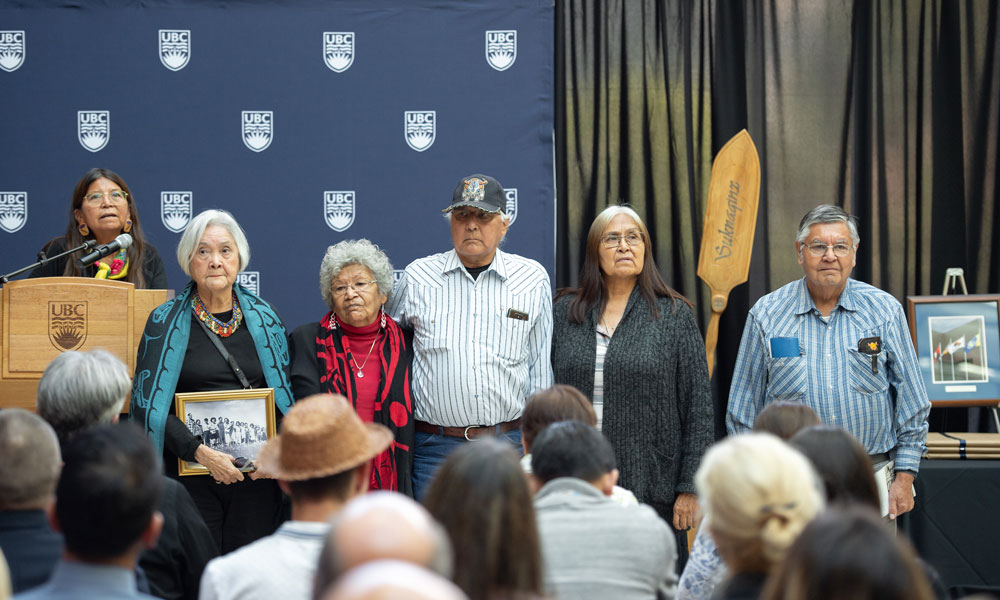
Pauline Terbasket (at microphone) honours Indian residential school survivors: the late Dr. Rosalyn Ing (holding a photo of her siblings who also attended), Eleanor Eli, Eric Mitchell, Sharon Lindley and Hubert George.
Day 4: How to be allies for future generations
The fourth and final day of our cultural safety workshop is a community engagement day. Several Indigenous students take time out of their busy schedules to join our circle. They introduce themselves: a graduate student, a postdoctoral fellow and two undergraduate students. One student shares how she lost several family members and friends to suicide in a single month. We hear stories of intergenerational trauma and its effect on communities. But we also hear stories of success from students who have come to UBCO to obtain an education and create positive change.
As they share, I am able to watch my own response. It’s different than it would have been on day one or two of this workshop. It seems like we are all listening in this circle in a new way. Tears are welling up in my eyes. Not because I am sad for the students but because it no longer feels like us and them. There is a genuine sense of connection, reciprocity and deep respect. I feel a change from an intellectual to a heartfelt understanding.
“Racism doesn’t come from the heart—it comes from the mind,” I hear Marchand say.
Together, we have learned to let go of things that held us back from really understanding. With this clearer connection to what cultural safety and reconciliation actually mean and a much deeper understanding of the work it takes, I say a heartfelt Lim’lempt—thank you—to Marchand and Mitchell. Through the workshop, they’ve given another handful of people tools to become real allies on Canada’s long journey towards reconciliation.
At the signing of UBCO’s declaration, the nsyilxcn language reverberates through the hall as Amber Cardenas sings the Okanagan song.
“Racism doesn’t come from the heart—it comes from the mind.”
Armstrong reverently lifts her hands, palms facing upwards as she says, “We have such good allies here in this community and this institution. Really hardworking people and I really want to raise my hands to you.
“This is an important step today and I invite you all to be part of the ongoing process of reconciliation. It is all of our collective responsibility. It isn’t just the responsibility of institutions. Every one of us as individuals can find a way to be able to reconcile within ourselves and within our families and within our community members, the responsibility to make things better for our future generations.”
